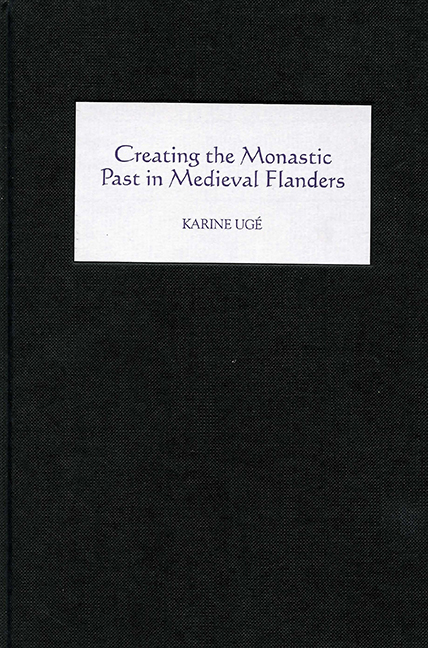Book contents
- Frontmatter
- Contents
- Acknowledgements
- Abbreviations
- Maps
- Genealogies
- Introduction
- Part I Saint-Bertin
- 1 Saint-Bertin from the Foundation to the Eleventh Century
- 2 Cultural Life at Saint-Bertin
- 3 Narrative Production at Saint-Bertin
- Part II The Hagiographic Cycle of St Rictrude
- Conclusion
- Bibliography
- Index
- Miscellaneous Endmatter
1 - Saint-Bertin from the Foundation to the Eleventh Century
from Part I - Saint-Bertin
Published online by Cambridge University Press: 12 September 2017
- Frontmatter
- Contents
- Acknowledgements
- Abbreviations
- Maps
- Genealogies
- Introduction
- Part I Saint-Bertin
- 1 Saint-Bertin from the Foundation to the Eleventh Century
- 2 Cultural Life at Saint-Bertin
- 3 Narrative Production at Saint-Bertin
- Part II The Hagiographic Cycle of St Rictrude
- Conclusion
- Bibliography
- Index
- Miscellaneous Endmatter
Summary
From the foundation to c. 800
The abbey of Saint-Bertin at Sithiu was founded by St Omer in the 640s. The foundation of the monastic community is closely associated with the establishment of the episcopal see of Thérouanne by St Omer, under the impetus of King Dagobert (623–639) and Acharius, bishop of Noyon (d. 640). The main source for the early history of Saint-Bertin and the bishopric of Thérouanne is the Vita Audomari Prima (VA1), written at Sithiu in the early ninth century. According to the vita, Omer was born in the region of Coutances (dep. Manche); at his mother's death, Friulfus and Omer left the Cotentin region for Burgundy, where they entered the monastery of Luxeuil, at the time ruled by St Columbanus's successor, Abbot Eustasius (615–629). Friulfus may have become acquainted with Luxeuil and Columbanian monasticism thanks to the activity of Potentinus, a disciple of Columbanus, who, according to the Vita Columbani, had gathered a cohort of monks in the Cotentin region. Luxeuil at this time was one of the major breeding grounds for ecclesiastical dignitaries, and Omer shared Eustasius's teachings with such men as Chagnoaldus the bishop of Laon, brother of St Faro, Ragnachar of Basel and the above-mentioned Acharius. Still, according to the VA1, Acharius himself recommended Omer to the king. Charles Mériaux has demonstrated that the designation of Omer as bishop of Thérouanne by Dagobert is to be understood in political and cultural terms. In the first decades of the seventh century, Morinie had become a pawn in the long-lasting conflict between the two regna of Neustria and Austrasia, and its control was coveted by Neustrian as well as Austrasian aristocrats. In 633, Dagobert gained control of the region and firmly submitted it to Neustrian authority. In this context, the choice of Omer, a man of Neustrian origin and a member of Columbanian circles, as bishop of Thérouanne was a clearly a way for the king to strengthen his grip over the region. That Omer was from Coutances is not meaningless either: the littoral regions, from Brittany to Morinie, were in close economic contact and their populations were culturally close.
Considering that Omer was designated bishop of Thérouanne during Dagobert's reign, the event must have taken place during the 630s.
- Type
- Chapter
- Information
- Creating the Monastic Past in Medieval Flanders , pp. 19 - 36Publisher: Boydell & BrewerPrint publication year: 2005

